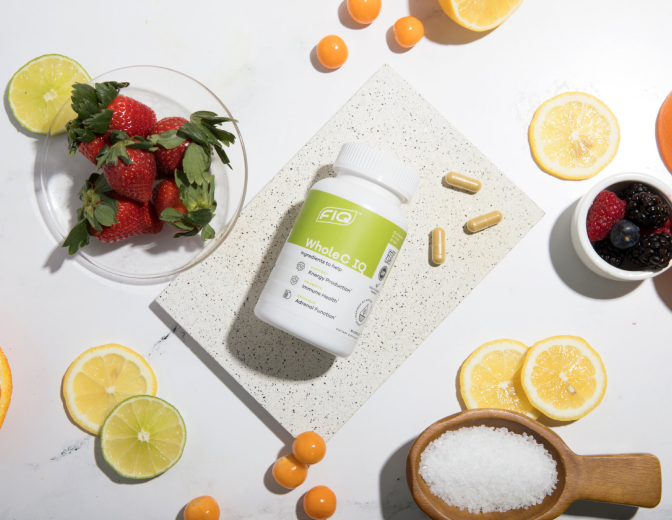Does Your Vitamin D Have a “Plus One?”
Research shows that low vitamin D is associated with inflammation and metabolic diseases (1), so supplementing to add more should fix the problem, right? (2). Not exactly. Many studies show only marginal improvements to health outcomes by supplementing with vitamin D (3, 4, 5)
A closer look reveals that low D levels are a consequence of chronic inflammation rather than the cause (5, 6, 7). In this scenario, supplementing with more vitamin D does not correct the root cause. In fact, when internal conditions are balanced, we can produce and maintain enough vitamin D to support health (8, 9, 10, 11). So what’s missing?
Vitamin D depends on other nutrients to work correctly. Even in extreme cases like Rickets, studies show that vitamin D alone is not causal in the development of this disease. Calcium-deficient diets cause low vitamin D and phosphorus levels, which result in Rickets (12, 13, 14). Adequate calcium intake is not of concern in developed nations.
Vitamin D Blood Tests - Not the Full Story
Vitamin D is a potent epigenetic steroid hormone (steroid hormone means it’s synthesized from cholesterol) (15). When we assess other hormones, we look at their free and bound forms to understand a complete picture of their actions and functions. But not for vitamin D.
The basic blood test for vitamin D assesses the storage form 25OH(D). Few people test their active form, 1,25OH(D). It’s possible, and quite likely, that the storage form is low while the active form is normal or elevated (5). It’s ideal to assess both markers. Only then can we make well-informed clinical decisions.
Vitamin D Doesn’t Work Alone
We also require adequate vitamin A (retinol) for optimal vitamin D function. For vitamin D to elicit its actions within the cell, it must first bind to the vitamin D receptor (VDR). VDR expression and bind capacities are dependent upon retinol (16, 17). Without it, Vitamin D can’t activate cellular functions.
At the tissue level, retinol stimulates:
- The growth of new cells.
- It’s vital for developing the lungs, heart, and eyes.
- It’s essential for producing keratin in your skin (18).
- It acts as the gatekeeper, allowing vitamin D access to DNA, where it turns on or off specific genes (16, 17).
- It suppresses vitamin D degradation, thereby maintaining balanced levels of it (19, 20).
- High doses of retinol can also offset vitamin D toxicity (21).
- They counterbalance one another (22, 23).
A Balancing Act
Balance between vitamins A and D is essential for either to function optimally and effectively. Each plays a specific role in regulating the immune system.Vitamin D has a strong influence on the innate immune response. This is the first line of defense against pathogenic invaders. It produces inflammatory cytokines associated with chronic inflammation (5).
Vitamin A is a potent adaptive immune regulator. This is the “memory” of the immune system or the antibodies we make against infections - how we develop immunity and autoimmunity (24).
Low vitamin A is associated with an increased risk for autoimmune disease (25). A balance between innate and adaptive immunity helps us fight off and overcome pathogenic or viral illnesses, prevent autoimmunity, and keep inflammation in check (23).
Vitamin D is Not the Only Sunlight Vitamin
Before vitamin A can activate the vitamin D receptor, it must be broken down into metabolites (17). Sunlight turns retinol into active retinoids that enhance the effect of vitamin D (26). Adequate light exposure is essential for regulating the levels of both vitamins (23).
Studies suggest that taking vitamins A and D together enhances the effect of each (23, 27). The Weston A. Price Foundation also supports taking the vitamins together (28, 29).
Liver is a rich source of retinol and was commonly consumed by our ancestors. Cod liver oil is an ancestral superfood and one of the oldest known remedies for boosting immunity. It’s one of nature's highest sources of both vitamins A and D in the appropriate ratios that our bodies prefer. (27).
Health Benefits of Cod Liver Oil
- It has been shown to reduce respiratory illness in children by up to 58% (27).
- It improves joint stiffness and pain in people with rheumatoid arthritis (30).
- It reduces levels of depression (31).
- It lowers post-exertional inflammation levels (32).
- When given during the first year of life, cod liver oil decreases the risk of type 1 diabetes (33).
It’s important that your cod liver oil contains only naturally occurring A and D to get the most out of it. Many brands fortify their oil with synthetic A and D. This disrupts the natural balance and defeats the purpose of whole-food-based nutrients.
The naturally occurring vitamins are often lost during cleansing and stabilization processes. These are necessary to make the oils safe to consume and shelf-stable, but high temperatures will degrade these sensitive vitamins. This is another reason why companies add synthetic vitamins.
Formula IQ appreciates the vital role of these two nutrients in the balanced ratios nature provides. That’s why we use an older, more labor-intensive process for our Cod Liver IQ that many companies have abandoned for easier methods. We remove vitamins A and D before beginning the cleaning process. Once the oil is safe from going rancid and shelf-stable, we add them back in.
This takes more time and effort to produce, but it’s also why we have cod liver oil with the highest level of naturally occurring vitamin D on the market, with no synthetic retinol and no preservatives or additives needed.





